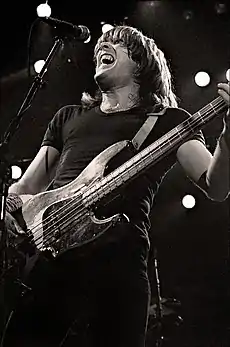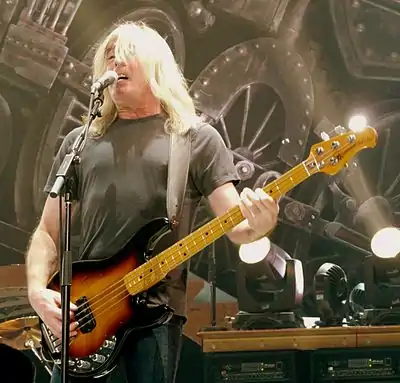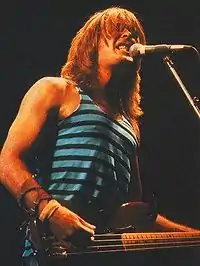Cliff Williams
Clifford Williams (born 14 December 1949) is an English musician, best known as the bassist and backing vocalist of the Australian hard rock band AC/DC. He started his professional music career in 1967 and had previously been in the English groups Home and Bandit. His first studio album with AC/DC was Powerage in 1978. Williams was inducted into the American Rock and Roll Hall of Fame as a member of AC/DC in 2003. Williams announced his retirement from AC/DC in 2016, but returned for their 2020 comeback album Power Up along with band mates Brian Johnson and Phil Rudd. His side projects include benefit concerts.
Cliff Williams | |
|---|---|
 Williams performing with AC/DC in 1982 | |
| Background information | |
| Birth name | Clifford Williams |
| Born | 14 December 1949 Romford, Essex, England |
| Origin | Hoylake, Merseyside, England |
| Genres | |
| Occupation(s) |
|
| Instruments |
|
| Years active | 1966–2016, 2018–present[1][2] |
| Labels | Columbia |
| Associated acts |
|
| Website | acdc |
Early life
Clifford Williams was born on 14 December 1949 in Romford, Essex.[3][4] In 1961, he moved with his family to Hoylake, Merseyside, where he was influenced by the local Merseybeat movement and decided to become a musician.[4][5] At the age of 13, he and some friends formed a band.[4] He listed The Rolling Stones, The Who, The Kinks, and blues musicians such as Bo Diddley as influences, and mostly learned to play bass by "listening to records and picking out notes", with his formal training limited to some lessons from a professional bassist in nearby Liverpool.[6] He left school when he was 16 years old, working as an engineer by day and musician by night.[5]
Career
Early career
In 1966, Williams moved to London,[4][5] where he worked at a demolition site and in supermarkets while playing in various short-lived bands.[3] He met guitarist Laurie Wisefield (later a member of Wishbone Ash) and the two became members of a band, Sugar, which soon broke up.[4][7][8] In 1970, Williams and Wisefield joined with singer Mick Stubbs, keyboardist Clive John, and drummer Mick Cook to form the progressive rock group Home.[4][7] The band signed a recording deal with Epic Records and issued their debut LP, Pause for a Hoarse Horse, in 1971.[8] Home was a supporting act for Jeff Beck, Mott the Hoople, The Faces and Led Zeppelin.[4]
In 1972, Jim Anderson replaced John on keyboards and Home released a self-titled album, featuring their only hit single, "Dreamer", which peaked at No. 41 in the UK album charts.[9] Their next album, The Alchemist, followed in 1973, but did not gain chart success. When British folk singer-songwriter Al Stewart suggested that Home back him on his first American tour in March 1974, Mick Stubbs left the group. The rest of the members became the Al Stewart Band, but split up after the tour.[7][8] Williams briefly played with the American band Stars before forming Bandit in 1974.[3][7] Bandit's line-up included vocalist Jim Diamond and drummer Graham Broad (later in Bucks Fizz and Roger Waters's band). The group signed with Arista Records and released a self-titled album in 1977. Bandit also performed as Alexis Korner's backing band on 1977's The Lost Album before disbanding later that year.[7][9][10]
AC/DC


Williams considered retiring from music following Bandit's breakup, but one of the group's guitarists, Jimmy Litherland, convinced him to audition for the Australian group AC/DC, who were looking for a bassist after firing Mark Evans shortly after recording their 1977 studio album Let There Be Rock.[11][12] AC/DC had formed in Australia in 1973 and by mid-1977 the line-up was Malcolm Young on rhythm guitar and backing vocals alongside his brother Angus Young on lead guitar, Phil Rudd on drums and Bon Scott on vocals.[7][13] Shortly after deciding to audition for the band, Williams saw AC/DC on Top of the Pops and was impressed,[5] describing them as "outrageous".[14]
For his audition, Williams played four jam sessions with the band,[14] and on 27 May 1977 was officially asked to join AC/DC. Angus declared the decision was partially motivated by the bassist's good looks, which the band hoped would attract more women to their concerts.[15] As Williams was replacing an Australian musician, there were issues resulting in problems obtaining a work permit to enter the country.[16] His first performances with AC/DC were in Australia supporting the Let There Be Rock album,[4] with two secret gigs at Sydney's Lifesaver.[17] The album Powerage (1978), produced by Vanda & Young, marked Williams's studio debut.[7][13][18] Williams remained in AC/DC from that time onwards until 2016,[19][4][13] with only a temporary departure in 1991 as he suffered a kidney infection, during which Paul Greg had to play bass for some North American concerts in the Razors Edge World Tour.[20] In addition to his role as bassist with AC/DC, Williams also contributed backing vocals.[4] He has said that his favourite albums with the band are Powerage and Back in Black.[21]
Side projects
In 1984, Williams played bass and backing vocals on Adam Bomb's song "I Want My Heavy Metal", for the album Fatal Attraction.[22] During AC/DC's hiatus in the 2000s, Williams joined Bosnian musician Emir Bukovica's band Emir & Frozen Camels. The group recorded the album San in 2002 and played in some European clubs.[23] In 2005, Williams and AC/DC singer Johnson played in a hurricane relief event in Florida, promoted by the John Entwistle Foundation. There Williams met drummer Steve Luongo, president of the foundation and former member of the John Entwistle band. Luongo later brought Williams, Johnson, and guitarist Mark Hitt for the Classic Rock Cares charity project. The quartet composed and recorded ten tracks in the studio in 2007, and followed that with a tour to raise funds for the foundation.[21][24][25] In 2011, Williams played on a benefit concert organized by Mark Farner.[26][27] Williams said he also occasionally plays with a rhythm and blues band from Fort Myers called The Juice.[6]
Retirement and return
On 7 July 2016, Williams announced his plans to retire from the music industry following AC/DC's Rock or Bust World Tour. He cited his opinion that AC/DC was now "a changed animal" with the recent departures of several core band members; Malcolm Young could no longer contribute due to dementia, Phil Rudd could not tour due to being under house arrest, and Brian Johnson was forced into retirement due to hearing problems.[19] In September 2016, during his last performance with AC/DC at the Wells Fargo Center in Philadelphia, Williams was brought to the front of the stage by Angus Young to take a bow in the middle of "For Those About to Rock (We Salute You)".[28] On September 30, 2020, AC/DC officially confirmed that Williams, along with fellow band mates Brian Johnson and Phil Rudd, have rejoined the band.[29]
Accolades
Since Williams' introduction to the band, AC/DC has been inducted to the Australian Recording Industry Association's Hall of Fame (in 1988),[30] and the Rock and Roll Hall of Fame (in 2003).[31] In 1982, Williams was chosen as "Bassist of the Year" in a vote conducted by Kerrang! magazine.[32]
Personal life
Williams married his American wife Georganne in 1980. They have two children: model and actress Erin Lucas (born 1985)[33] and Luke (born 1986).[34] The couple initially settled in Hawaii,[12] but this left them feeling too isolated, and they found the school system to be lacking. In 1986, they moved to Fort Myers, Florida, at the suggestion of AC/DC bandmate and nearby Sarasota resident Brian Johnson.[11] Williams also spends time in the French city of Aix-en-Provence, where he has distant relatives. Williams' hobbies include fishing,[26] flying,[14] and wine.[35]
Style
Williams' role in AC/DC was to provide steady but basic basslines which followed the rhythm guitar of Malcolm Young,[4] consisting mostly of eighth notes.[36] His basslines were sometimes written by Malcolm and Angus Young during composition, and at other times Williams developed them based on the other instrumental tracks.[37] Williams has said of his playing, "It's not the [bass] line that counts. It is the feel. My favorite AC/DC tune to play is 'Down Payment Blues', because it's so simple. I play four notes throughout the song, but I get off on the whole thing—not me noodlin' away."[14] He also said that he plays "the same thing in every song, for the most part [...] in AC/DC's music, the song is more important than any individual's bit in it".[38] He added that "complex [bass] lines wouldn't add anything to a guitar-oriented band like [AC/DC], so [he tries] to create a bottom layer that drives what [AC/DC's] guys are doing on top".[14] Williams had no difficulty keeping his low profile within the band, declaring, "I don't have any problem doing this, because I enjoy playing simply. I never feel angry or prisoner."[37] Nevertheless, he very occasionally employs more melodic lines and passing notes on some songs, such as Satellite Blues. His playing technique is mostly centred around downpicking, with the occasional use of plucking to mute the strings, which he says "adds more definition and tightens up the notes, and it gives the sound less sustain".[14]
Equipment
In his first appearance in 1977, he used a Gibson Ripper only for the "Let There Be Rock" music video. Williams' trademark instrument is the StingRay and other basses by Music Man, strung with D'Addario (.045, .065, .085, .105) flatwounds in the studio and roundwound XLs in concert.[39] In October 2020, Ernie Ball Music Man announced that they are releasing a Cliff Williams Signature Bass which will be a genuine replica of his 1979 Music Man StingRay bass. Williams states that despite trying other basses over the years, he always went back to Music Man's instruments, which he described as "a tremendous work horse of a bass".[5] Other basses used include the Fender Precision Bass,[14] a Gibson Thunderbird non-reverse, Fender Jazz Bass,[40] the Steinberger L-series,[41] a Gibson EB-3 and at least two LAG Custom basses. Williams used 3 Ampeg SVT-810E cabinets with 2 SVT-4PRO Heads, but if there was any interference with the wireless systems, he used cables in his live performances.[39]
Notes
- https://ultimateclassicrock.com/acdc-cliff-williams-returns/
- https://loudwire.com/is-cliff-williams-back-acdc/
- Sutcliffe 2010, p. 57.
- Rivadavia.
- Fox, Gene; Fowler, Dave (30 October 2010). "Video Interview: Cliff Williams of AC/DC". Bass Frontiers Magazine. Retrieved 11 September 2011.
- Duclos, Michael (March 1995). "The High Voltage bass power of AC/DC's Cliff Williams". Guitar School.
- Holmgren, Magnus. "AC/DC". Australian Rock Database. Magnus Holmgren. Archived from the original on 2 April 2012. Retrieved 18 September 2011.
- "Band Member Profiles: Laurie Wisefield – Guitar/Vocals". Wishbone Ash Official Website. Archived from the original on 29 September 2011. Retrieved 11 September 2011.
- Sutcliffe 2010, p. 213.
- "Alexis Korner 'The Lost Album'". AlexisKorner.net. Archived from the original on 4 July 2011. Retrieved 20 March 2011.
- "Conversation: "It's Like Razor Blades Out There"". Gulf Shore Magazine. April 2007. Archived from the original on 11 July 2011.
- Billson, Marky (29 August 2008). "Let There Be Rock: AC/DC @ the 'Dillo". Austin Chronicle. Retrieved 11 September 2011.
- McFarlane, Ian. "Encyclopedia entry for 'AC/DC'". Whammo.com.au. Archived from the original on 6 August 2004. Retrieved 13 November 2011.
- Scott M (May 1996). "Cliff Williams of AC/DC: Let There Be Bass". Bass Player. Miller Freeman.
- Masino 2009, p. 74.
- Sutcliffe 2010, p. 69.
- Kimball, Duncan (2002). "AC/DC". Milesago: Australasian Music and Popular Culture 1964–1975. Ice Productions. Retrieved 18 September 2011.
- Janssen, Volker (August–September 1998). "Interview with Mark Eans". Daily Dirt. Archived from the original on 5 January 2011. Retrieved 19 February 2011.
- Foerste, Jonathan (July 2016). "Still Rockin' in Southwest Florida". Gulfshore Life. Archived from the original on 12 June 2017. Retrieved 8 July 2016.
- Masino 2009, p. 178.
- Orwat Jr., Thomas S. (4 October 2009). "Interview: Cliff Williams—Classic Rock Cares". RockMusicStar.com. Archived from the original on 21 April 2012. Retrieved 11 September 2011.
- "Adam Bomb". Jimmy Crespo. Retrieved 20 March 2011.
- "Bio". Emir & Frozen Camels. Retrieved 20 March 2011.
- "Classic Rock Cares". The John Entwistle Foundation. Archived from the original on 14 September 2011. Retrieved 20 March 2011.
- "SteveLuongoArt.com / Bio". SteveLuongoArt.com. Archived from the original on 10 September 2012. Retrieved 20 March 2011.
- "AC/DC Talks Tour Success in 2010, Plans for 2011". Artisan News Service. 20 January 2011. Retrieved 15 November 2011.
- "Roger Daltrey and Mark Farner Rock for Jesse". MarkFarner.com. 11 January 2011. Archived from the original on 8 September 2012. Retrieved 11 September 2011.
- Kreps, Daniel (21 September 2016). "Watch AC/DC Salute Cliff Williams at Bassist's Final Show". Rolling Stone. Retrieved 18 November 2017.
- Moore (30 September 2020). "AC/DC confirm comeback and return of Brian Johnson, Phil Rudd and Cliff Williams". NME. Retrieved 30 September 2020.
- "ARIA Icons: Hall of Fame". Australian Recording Industry Association. Archived from the original on 26 November 2009. Retrieved 2 August 2008.
- "Inductees: AC/DC". Rock and Roll Hall of Fame. Retrieved 11 September 2011.
- Sutcliffe 2010, p. 122.
- Wieselman, Jarett (24 September 2009). "Pulling Back The Curtain on 'The City's' Erin". New York Post. Archived from the original on 24 January 2009.
- "Scene & Heard". Gulf Shore Magazine. May 2007.
- Katherine Cole, Q&A: Cliff Williams, AC/DC, wine-searcher.com, 27 February 2013
- Welch, Ernie (2003). Powerage (CD). AC/DC. Epic Records.
- "Cliff Williams: The Cool Power". Hard Rock Mag. December 1996.
- Fricke, David (13 November 2008). "AC/DC and the Gospel of Rock & Roll". Rolling Stone. Wenner Media LLC. Archived from the original on 5 May 2009. Retrieved 18 March 2011.
- St. James, Adam. "High Voltage: AC/DC's High Powered Rig". Guitar.com. Retrieved 11 September 2011. Alt URL
- Voccia, Bill. "AC/DC Info Base". Highway to Hell. Archived from the original on 5 January 2011. Retrieved 11 September 2011.
- "Hard Rock Memorabilia: Cliff Williams – AC/DC – Steinberger bass" (Microsoft Silverlight). Hard Rock Cafe. Retrieved 11 September 2011.
References
- Masino, Susan (2009). Let There Be Rock: The Story of AC/DC. Omnibus Press. ISBN 978-0-8256-3701-8.
- Rivadavia, Eduardo. "Cliff Williams". Allmusic. Rovi Corporation. Retrieved 11 September 2011.
- Sutcliffe, Phil (2010). AC/DC: High-Voltage Rock 'n' Roll: The Ultimate Illustrated History. Minneapolis, MN: Voyageur Press. ISBN 978-0-7603-3832-2.